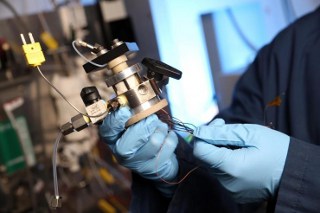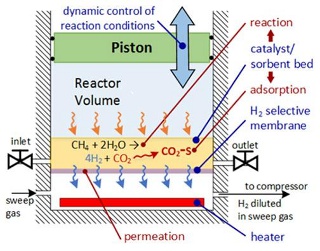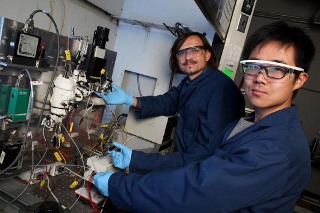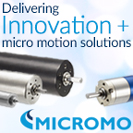 |
| March 14, 2017 | Volume 13 Issue 10 |
Motion Control News & Products
Designfax weekly eMagazine
Archives
Partners
Manufacturing Center
Product Spotlight
Modern Applications News
Metalworking Ideas For
Today's Job Shops
Tooling and Production
Strategies for large
metalworking plants
Overhung load adaptors provide load support and contamination protection
 Overhung load adaptors (OHLA) provide both overhung radial and axial load support to protect electrified mobile equipment motors from heavy application loads, extending the lifetime of the motor and alleviating the cost of downtime both from maintenance costs and loss of production. They seal out dirt, grime, and other contaminants too. Zero-Max OHLAs are available in an extensive offering of standard models (including Extra-Duty options) for typical applications or customized designs.
Overhung load adaptors (OHLA) provide both overhung radial and axial load support to protect electrified mobile equipment motors from heavy application loads, extending the lifetime of the motor and alleviating the cost of downtime both from maintenance costs and loss of production. They seal out dirt, grime, and other contaminants too. Zero-Max OHLAs are available in an extensive offering of standard models (including Extra-Duty options) for typical applications or customized designs.
Learn more.
Why choose electric for linear actuators?
 Tolomatic has been delivering a new type of linear motion technology that is giving hydraulics a run for its money. Learn the benefits of electric linear motion systems, the iceberg principle showing total cost of ownership, critical parameters of sizing, and conversion tips.
Tolomatic has been delivering a new type of linear motion technology that is giving hydraulics a run for its money. Learn the benefits of electric linear motion systems, the iceberg principle showing total cost of ownership, critical parameters of sizing, and conversion tips.
Get this informative e-book. (No registration required)
New AC hypoid inverter-duty gearmotors
 Bodine Electric Company introduces 12 new AC inverter-duty hypoid hollow shaft gearmotors. These type 42R-25H2 and 42R-30H3 drives combine an all-new AC inverter-duty, 230/460-VAC motor with two hypoid gearheads. When used with an AC inverter (VFD) control, these units deliver maintenance-free and reliable high-torque output. They are ideal for conveyors, gates, packaging, and other industrial automation equipment that demands both high torque and low power consumption from the driving gearmotor.
Bodine Electric Company introduces 12 new AC inverter-duty hypoid hollow shaft gearmotors. These type 42R-25H2 and 42R-30H3 drives combine an all-new AC inverter-duty, 230/460-VAC motor with two hypoid gearheads. When used with an AC inverter (VFD) control, these units deliver maintenance-free and reliable high-torque output. They are ideal for conveyors, gates, packaging, and other industrial automation equipment that demands both high torque and low power consumption from the driving gearmotor.
Learn more.
Next-gen warehouse automation: Siemens, Universal Robots, and Zivid partner up
 Universal Robots, Siemens, and Zivid have created a new solution combining UR's cobot arms with Siemens' SIMATIC Robot Pick AI software and Zivid's 3D sensors to create a deep-learning picking solution for warehouse automation and intra-logistics fulfillment. It works regardless of object shape, size, opacity, or transparency and is a significant leap in solving the complex challenges faced by the logistics and e-commerce sectors.
Universal Robots, Siemens, and Zivid have created a new solution combining UR's cobot arms with Siemens' SIMATIC Robot Pick AI software and Zivid's 3D sensors to create a deep-learning picking solution for warehouse automation and intra-logistics fulfillment. It works regardless of object shape, size, opacity, or transparency and is a significant leap in solving the complex challenges faced by the logistics and e-commerce sectors.
Read the full article.
Innovative DuoDrive gear and motor unit is UL/CSA certified
 The DuoDrive integrated gear unit and motor from NORD DRIVE-SYSTEMS is a compact, high-efficiency
solution engineered for users in the fields of intralogistics, pharmaceutical, and the food and beverage industries. This drive combines a IE5+ synchronous motor and single-stage helical gear unit into one compact housing with a smooth, easy-to-clean surface. It has a system efficiency up to 92% and is available in two case sizes with a power range of 0.5 to 4.0 hp.
The DuoDrive integrated gear unit and motor from NORD DRIVE-SYSTEMS is a compact, high-efficiency
solution engineered for users in the fields of intralogistics, pharmaceutical, and the food and beverage industries. This drive combines a IE5+ synchronous motor and single-stage helical gear unit into one compact housing with a smooth, easy-to-clean surface. It has a system efficiency up to 92% and is available in two case sizes with a power range of 0.5 to 4.0 hp.
Learn more.
BLDC flat motor with high output torque and speed reduction
 Portescap's 60ECF brushless DC slotted flat motor is the newest frame size to join its flat motor portfolio. This 60-mm BLDC motor features a 38.2-mm body length and an outer-rotor slotted configuration with an open-body design, allowing it to deliver improved heat management in a compact package. Combined with Portescap gearheads, it delivers extremely high output torque and speed reduction. Available in both sensored and sensorless options. A great choice for applications such as electric grippers and exoskeletons, eVTOLs, and surgical robots.
Portescap's 60ECF brushless DC slotted flat motor is the newest frame size to join its flat motor portfolio. This 60-mm BLDC motor features a 38.2-mm body length and an outer-rotor slotted configuration with an open-body design, allowing it to deliver improved heat management in a compact package. Combined with Portescap gearheads, it delivers extremely high output torque and speed reduction. Available in both sensored and sensorless options. A great choice for applications such as electric grippers and exoskeletons, eVTOLs, and surgical robots.
Learn more and view all the specs.
Application story: Complete gearbox and coupling assembly for actuator system
 Learn how GAM engineers not only sized and selected the appropriate gear reducers and couplings required to drive two ball screws in unison using a single motor, but how they also designed the mounting adapters necessary to complete the system. One-stop shopping eliminated unnecessary components and resulted in a 15% reduction in system cost.
Learn how GAM engineers not only sized and selected the appropriate gear reducers and couplings required to drive two ball screws in unison using a single motor, but how they also designed the mounting adapters necessary to complete the system. One-stop shopping eliminated unnecessary components and resulted in a 15% reduction in system cost.
Read this informative GAM blog.
Next-gen motor for pump and fan applications
 The next evolution of the award-winning Aircore EC motor from Infinitum is a high-efficiency system designed to power commercial and industrial applications such as HVAC fans, pumps, and data centers with less energy consumption, reduced emissions, and reduced waste. It features an integrated variable frequency drive and delivers upward of 93% system efficiency, as well as class-leading power and torque density in a low-footprint package that is 20% lighter than the previous version. Four sizes available.
The next evolution of the award-winning Aircore EC motor from Infinitum is a high-efficiency system designed to power commercial and industrial applications such as HVAC fans, pumps, and data centers with less energy consumption, reduced emissions, and reduced waste. It features an integrated variable frequency drive and delivers upward of 93% system efficiency, as well as class-leading power and torque density in a low-footprint package that is 20% lighter than the previous version. Four sizes available.
Learn more.
Telescoping linear actuators for space-constrained applications
 Rollon's new TLS telescoping linear actuators enable long stroke lengths with minimal closed lengths, which is especially good for applications with minimal vertical clearance. These actuators integrate seamlessly into multi-axis systems and are available in two- or three-stage versions. Equipped with a built-in automated lubrication system, the TLS Series features a synchronized drive system, requiring only a single motor to achieve motion. Four sizes (100, 230, 280, and 360) with up to 3,000-mm stroke length.
Rollon's new TLS telescoping linear actuators enable long stroke lengths with minimal closed lengths, which is especially good for applications with minimal vertical clearance. These actuators integrate seamlessly into multi-axis systems and are available in two- or three-stage versions. Equipped with a built-in automated lubrication system, the TLS Series features a synchronized drive system, requiring only a single motor to achieve motion. Four sizes (100, 230, 280, and 360) with up to 3,000-mm stroke length.
Learn more.
Competitively priced long-stroke parallel gripper
 The DHPL from Festo is a new generation of pneumatic long-stroke grippers that offers a host of advantages for high-load and high-torque applications. It is interchangeable with competitive long-stroke grippers and provides the added benefits of lighter weight, higher precision, and no maintenance. It is ideal for gripping larger items, including stacking boxes, gripping shaped parts, and keeping bags open. It has high repetition accuracy due to three rugged guide rods and a rack-and-pinion design.
The DHPL from Festo is a new generation of pneumatic long-stroke grippers that offers a host of advantages for high-load and high-torque applications. It is interchangeable with competitive long-stroke grippers and provides the added benefits of lighter weight, higher precision, and no maintenance. It is ideal for gripping larger items, including stacking boxes, gripping shaped parts, and keeping bags open. It has high repetition accuracy due to three rugged guide rods and a rack-and-pinion design.
Learn more.
Extend your range of motion: Controllers for mini motors
 FAULHABER has added another extremely compact Motion Controller without housing to its product range. The new MC3603 controller is ideal for integration in equipment manufacturing and medical tech applications. With 36 V and 3 A (peak current 9 A), it covers the power range up to 100 W and is suitable for DC motors with encoder, brushless drives, or linear motors.
FAULHABER has added another extremely compact Motion Controller without housing to its product range. The new MC3603 controller is ideal for integration in equipment manufacturing and medical tech applications. With 36 V and 3 A (peak current 9 A), it covers the power range up to 100 W and is suitable for DC motors with encoder, brushless drives, or linear motors.
Learn more.
When is a frameless brushless DC motor the right choice?
 Frameless BLDC motors fit easily into small, compact machines that require high precision, high torque, and high efficiency, such as robotic applications where a mix of low weight and inertia is critical. Learn from the experts at SDP/SI how these motors can replace heavier, less efficient hydraulic components by decreasing operating and maintenance costs. These motors are also more environmentally friendly than others.
Frameless BLDC motors fit easily into small, compact machines that require high precision, high torque, and high efficiency, such as robotic applications where a mix of low weight and inertia is critical. Learn from the experts at SDP/SI how these motors can replace heavier, less efficient hydraulic components by decreasing operating and maintenance costs. These motors are also more environmentally friendly than others.
View the video.
Tiny and smart: Step motor with closed-loop control
 Nanotec's new PD1-C step motor features an integrated controller and absolute encoder with closed-loop control. With a flange size of merely 28 mm (NEMA 11), this compact motor reaches a max holding torque of 18 Ncm and a peak current of 3 A. Three motor versions are available: IP20 protection, IP65 protection, and a motor with open housing that can be modified with custom connectors. Ideal for applications with space constraints, effectively reducing both wiring complexity and installation costs.
Nanotec's new PD1-C step motor features an integrated controller and absolute encoder with closed-loop control. With a flange size of merely 28 mm (NEMA 11), this compact motor reaches a max holding torque of 18 Ncm and a peak current of 3 A. Three motor versions are available: IP20 protection, IP65 protection, and a motor with open housing that can be modified with custom connectors. Ideal for applications with space constraints, effectively reducing both wiring complexity and installation costs.
Learn more.
Closed loop steppers drive new motion control applications
 According to the motion experts at Performance Motion Devices, when it comes to step motors, the drive technique called closed loop stepper is making everything old new again and driving a burst of interest in the use of two-phase step motors. It's "winning back machine designers who may have relegated step motors to the category of low cost but low performance."
According to the motion experts at Performance Motion Devices, when it comes to step motors, the drive technique called closed loop stepper is making everything old new again and driving a burst of interest in the use of two-phase step motors. It's "winning back machine designers who may have relegated step motors to the category of low cost but low performance."
Read this informative Performance Motion Devices article.
Intelligent compact drives with extended fieldbus options
 The intelligent PD6 compact drives from Nanotec are now available with Profinet and EtherNet/IP. They combine motor, controller, and encoder in a space-saving package. With its 80-mm flange and a rated power of 942 W, the PD6-EB is the most powerful brushless DC motor of this product family. The stepper motor version has an 86-mm flange (NEMA 34) and a holding torque up to 10 Nm. Features include acceleration feed forward and jerk-limited ramps. Reduced installation time and wiring make the PD6 series a highly profitable choice for machine tools, packaging machines, or conveyor belts.
The intelligent PD6 compact drives from Nanotec are now available with Profinet and EtherNet/IP. They combine motor, controller, and encoder in a space-saving package. With its 80-mm flange and a rated power of 942 W, the PD6-EB is the most powerful brushless DC motor of this product family. The stepper motor version has an 86-mm flange (NEMA 34) and a holding torque up to 10 Nm. Features include acceleration feed forward and jerk-limited ramps. Reduced installation time and wiring make the PD6 series a highly profitable choice for machine tools, packaging machines, or conveyor belts.
Learn more.
New spin on old tech: Four-stroke engine cycle produces hydrogen from methane and captures CO2

Georgia Tech researchers have demonstrated a CHAMP reactor, which uses the four-stroke engine cycle to create hydrogen while simultaneously capturing carbon dioxide emissions. [Credit: Candler Hobbs, Georgia Tech]
By John Toon, Georgia Tech
When is an internal combustion engine not an internal combustion engine? When it's been transformed into a modular reforming reactor that could make hydrogen available to power fuel cells wherever there's a natural gas supply available.
By adding a catalyst, a hydrogen separating membrane, and carbon dioxide sorbent to the century-old four-stroke engine cycle, researchers have demonstrated a laboratory-scale hydrogen reforming system that produces the green fuel at relatively low temperature in a process that can be scaled up or down to meet specific needs. The process could provide hydrogen at the point of use for residential fuel cells or neighborhood power plants, electricity and power production in natural-gas powered vehicles, fueling of municipal buses or other hydrogen-based vehicles, and supplementing intermittent renewable energy sources such as photovoltaics.
Known as the CO2/H2 Active Membrane Piston (CHAMP) reactor, the device operates at temperatures much lower than conventional steam reforming processes, consumes substantially less water, and could also operate on other fuels such as methanol or bio-derived feedstock. It also captures and concentrates carbon dioxide emissions, a by-product that now lacks a secondary use -- though that could change in the future.
Unlike conventional engines that run at thousands of revolutions per minute, the reactor operates at only a few cycles per minute -- or more slowly -- depending on the reactor scale and required rate of hydrogen production. And there are no spark plugs, because there's no fuel combusted.

Schematic shows the components of a CHAMP cylinder-piston assembly used to create hydrogen from methane and steam via variable volume catalytic reaction. The process also concentrates carbon dioxide emissions from the process. [Credit: David Anderson, Georgia Tech]
"We already have a nationwide natural gas distribution infrastructure, so it's much better to produce hydrogen at the point of use rather than trying to distribute it," said Andrei Fedorov, a Georgia Institute of Technology professor who's been working on CHAMP since 2008. "Our technology could produce this fuel of choice wherever natural gas is available, which could resolve one of the major challenges with the hydrogen economy."
A paper published February 9 in the journal Industrial & Engineering Chemistry Research describes the operating model of the CHAMP process, including a critical step of internally adsorbing carbon dioxide, a byproduct of the methane reforming process, so it can be concentrated and expelled from the reactor for capture, storage, or utilization.
Other implementations of the system have been reported as thesis work by three Georgia Tech Ph.D. graduates since the project began in 2008. The research was supported by the National Science Foundation, the Department of Defense through NDSEG fellowships, and the U.S. Civilian Research & Development Foundation (CRDF Global).
Key to the reaction process is the variable volume provided by a piston rising and falling in a cylinder. As with a conventional engine, a valve controls the flow of gases into and out of the reactor as the piston moves up and down. The four-stroke system works like this:
- Natural gas (methane) and steam are drawn into the reaction cylinder through a valve as the piston inside is lowered. The valve closes once the piston reaches the bottom of the cylinder.
- The piston rises into the cylinder, compressing the steam and methane as the reactor is heated. Once it reaches approximately 400 deg C, catalytic reactions take place inside the reactor, forming hydrogen and carbon dioxide. The hydrogen exits through a selective membrane, and the pressurized carbon dioxide is adsorbed by the sorbent material, which is mixed with the catalyst.
- Once the hydrogen has exited the reactor and carbon dioxide is tied up in the sorbent, the piston is lowered, reducing the volume (and pressure) in the cylinder. The carbon dioxide is released from the sorbent into the cylinder.
- The piston is again moved up into the chamber and the valve opens, expelling the concentrated carbon dioxide and clearing the reactor for the start of a new cycle.

Georgia Tech professor Andrei Fedorov (left) and undergraduate research assistant Yuzhe Peng are shown with the laboratory-scale hydrogen reforming system that produces the green fuel at relatively low temperature in a process that can be scaled up or down to meet specific needs. [Credit: Candler Hobbs, Georgia Tech]
The project was begun to address some of the challenges to the use of hydrogen in fuel cells. Most hydrogen used today is produced in a high-temperature reforming process in which methane is combined with steam at about 900 deg C. The industrial-scale process requires as many as three water molecules for every molecule of hydrogen, and the resulting low-density gas must be transported to where it will be used.
Fedorov's lab first carried out thermodynamic calculations suggesting that the four-stroke process could be modified to produce hydrogen in relatively small amounts where it would be used. The goals of the research were to create a modular reforming process that could operate at between 400 and 500 deg C, use just two molecules of water for every molecule of methane to produce four hydrogen molecules, be able to scale down to meet the specific needs, and capture the resulting carbon dioxide for potential utilization or sequestration.
"We wanted to completely rethink how we designed reactor systems," said Fedorov. "To gain the kind of efficiency we needed, we realized we'd need to dynamically change the volume of the reactor vessel. We looked at existing mechanical systems that could do this, and realized that this capability could be found in a system that has had more than a century of improvements: the internal combustion engine."
The CHAMP system could be scaled up or down to produce the hundreds of kilograms of hydrogen per day required for a typical automotive refueling station -- or a few kilograms for an individual vehicle or residential fuel cell, Fedorov said. The volume and piston speed in the CHAMP reactor can be adjusted to meet hydrogen demands while matching the requirements for the carbon dioxide sorbent regeneration and separation efficiency of the hydrogen membrane. In practical use, multiple reactors would likely be operated together to produce a continuous stream of hydrogen at a desired production level.
"We took the conventional chemical processing plant and created an analog using the magnificent machinery of the internal combustion engine," Fedorov said. "The reactor is scalable and modular, so you could have one module or a hundred modules depending on how much hydrogen you needed. The processes for reforming fuel, purifying hydrogen, and capturing carbon dioxide emission are all combined into one compact system."
CITATION: David M. Anderson, Thomas M. Yun, Peter A. Kottke and Andrei G. Fedorov, "Comprehensive Analysis of Sorption Enhanced Steam Methane Reforming in a Variable Volume Membrane Reactor," (Industrial & Engineering Chemistry Research, 2017). http://dx.doi.org/10.1021/acs.iecr.6b04392
Published March 2017
Rate this article
View our terms of use and privacy policy

